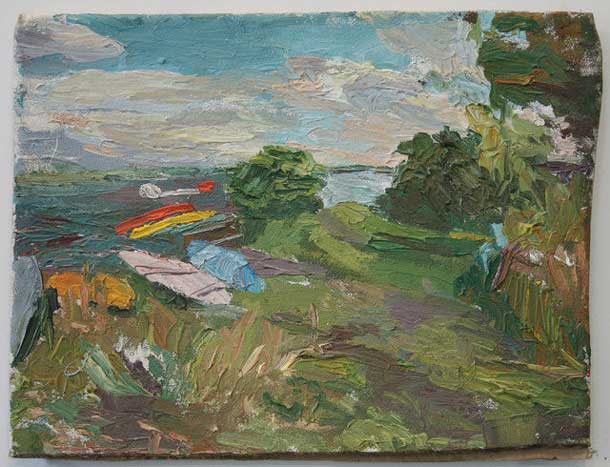
Stanley Lewis, STANLEY LEWIS Afternoon Study of Boats, oil on canvas, 9 1/2 × 12 1/2 inches – image courtesy of the Betty Cuningham Gallery
Review by Thaddeus Radell
Stanley Lewis’ current exhibition at the Betty Cunningham Gallery reaffirms his stature as a great landscape painter and goes beyond. I have been following Lewis’ work for a few years now with greater and greater attention, and I was poised for several hours of demanding visual engagement with his remarkably obsessive, robustly structured images. And indeed the work continues to stagger me with its almost overwhelming scope of intent and rigor of execution. This time, however, though my feelings relative to Lewis’ ever-impressive plastic virtuosity were, if anything, enhanced by his sheer honesty an biting devoutness to the motif, the exhibition was now breathing another, less pragmatic air, that of an inspired Faulknerian syntax of construction, and, most poignantly, a palpable sense of loss.
Lewis’ paintings dictate a precise sense of light and harmonize mesmerizing scales of urgent descriptive content. One sees a weathered wall, a weed-raged field, a gleaming white 18-wheeler, a few beached rowboats, a fence, a house, telephone lines. As one explores further and further into these pastoral kaleidoscopes, one can never exhaust the multiple layers of densely packed details nor the broad range of mark-making used to describe them. They are fiercely won painted trophies of intimate spaces ravaged by Lewis’ intrepid eye. The squared and multi-colored negative spaces that staccato a brick wall in Backyard Jeykll Island, GA (2014) or the white pointed red-stone pillars of Winslow Park, Westport (2010-2014) are truly delightful to discover and thrilling to visually digest. The deployment of details in the drawings is equally terrifying, be it the stacked crucifix of bricks that unites Family Group Based on Durer Woodprint (2012), the spanning rafters of Westport Train Station (2013) or the laced-to-infinity branches in the magnificent Hemlock Tress Seen from Upstairs Window in the Snow (2007-2014).
Of more interest, however, than Lewis’ prowess in amassing these seething layers of details is the dynamics that he employs to exceed both the details and the marks themselves. In this respect, a parallel drawn to Faulkner might be ventured. Faulkner wraps the broader scope of his narrative into a labyrinth of language that entangles time and space, creating profoundly evocative studies of the human psyche. Time, space, narrator, characters, plot and theme often leap ahead, double back or splinter off, only to find themselves part of a breathtaking orchestration, resulting in some of the most poignant tales in American literature. In a similar way, Lewis knots and weaves his painted or drawn passages into the formal context of his subject: in part, by literally cutting and pasting, and in part by recklessly juxtaposing areas of dissimilar spatial orientations. The assembly results in a densely tactile, rich phrasing while maintaining a certain buoyancy of light and atmosphere. Lewis reaches for his own heights of interpretation- almost in spite of his steadfast observation of the motif.
In both the paintings and drawings, the constant presence of cut and pieced bits of painted description is indeed stimulating to the eye, and subsequently keep the large quiet areas of the image as alive as the more visually pregnant passages of lush, brisk detail. The sky and snowy foreground of Hemlock do not lose vitality against the weight and density of the tree. The sky in Boat on the Beach is likewise as present as the scraggly field in the foreground. Moving beyond such astounding rigor, Lewis proceeds to heighten the intrigue of his pictures by punctuating them with passages of contradictory space—almost as coherently, if not as sublimely—as Faulkner does his novels with time/narrator vacillations. In his Snopes trilogy, for example, the plot weaves through shifts in the time frame and is told from the viewpoint of three different characters, all building into a thousand-page edifice of astounding insight. Likewise, Lewis does not limit himself automatically to the same spatial construct in adjoining areas although each part adds up to achieve a coherent and convincing whole. On the contrary, sections of the paintings are seamlessly juxtaposed (or sometimes not-so-seamlessly!) that allow alternative readings of the space. Lewis’ paintings/drawings are, in truth, syntheses of painted fragments, some of which are slightly out of tune with others and serve to syncopate the rhythm of the pictures and add to their rich meaning. Returning to those tightly observed pillars in Windsor Terrace, especially with the pillar on the right, the forms of the pillars become almost translucent and weightless as they blend into the road behind, becoming rippling stones in a blue-grey river of pavement. Other examples include the grey-violet boat on the left of Lake Chautauqua Boat Scene with Woman and Boy (2013) as it launches itself flatly against the picture plane, as opposed to the sculpted perspective of the other boats, or the windows of Backyard Jeykll Island, GA, that appear almost as small paintings hanging on the side of the house, or the erupting foreground of Matt Farnham’s Farm with Truck (2014) that plays so well off of that miracle of a white truck. Lewis, like Faulkner, is able to bind all of the elements of his pictures together into highly cohesive images, with his language and narrative tending to follow a sometimes jolting and circuitous, ambitious route.
Of all the revelations and delights that this exhibition offers, the most enduring are triggered by the majestic drawing that opens the exhibition, Hemlock Trees Seen from Upstairs Window in the Snow. Studying its impossibly fathomed and mapped depths of marks, lines of another sort came rippling unexpectedly into my mind.
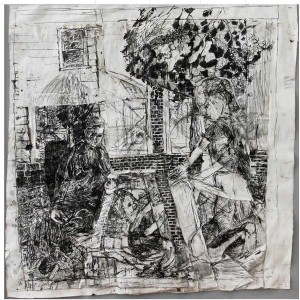
Stanley Lewis, Family Group Based on Durer Woodprint (2012),image courtesy of the Betty Cuningham Gallery
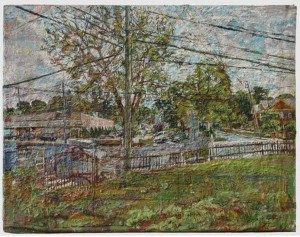
Stanley Lewis, Winslow Park, Westport (2010-2014) Oil on Canvas 21 1/4 x 35 1/4 inches – image courtesy of the Betty Cuningham Gallery
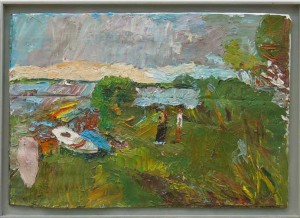
Stanley Lewis, Lake Chautauqua Boat Scene with Woman and Boy (2013) image courtesy of the Betty Cuningham Gallery
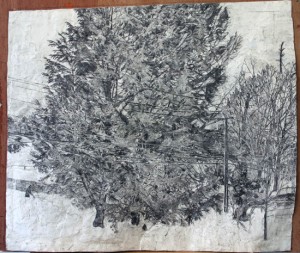
Stanley Lewis, Hemlock Trees Seen from Upstairs Window in the Snow – image courtesy of the Betty Cuningham Gallery
O plunge your hands in water,
Plunge them in up to the wrist;
Stare, stare in the basin
And wonder what you’ve missed.
What one is left with, in the end, upon truly contemplating and corresponding with Lewis’ work, is a poignant sense of loss. Lewis’ frantic quest for every detail and nuance, so desperate, so purposeful, unveils a broad sense of unease with capturing what he sees. The natural elements that he faces on the motif are so overwhelming that he must rip his work apart and reconstruct it after hours and hours of determined observation. Conversation with the artist is permeated with the difficulties faced by the painter in crossing the unbreachable threshold into true painting. This exhibition is often refreshed with such simply pronounced images as Late Eve Study of Boats (2013), Study for Big Painting (2013) and the joyful Woman and Boy by Lake (2013), but the weight of the major works—the drawings, again Hemlock and Trees and Family Group Based on Durer Woodprint (2012), and the paintings, Matt Farnham’s Farm with Truck (2014) and Boat on the Beach, Lake Chautauqua (2013)—drive the exhibition and point to a state of pathos, the defeat of the hero at the hands of the gods. Lewis is a hero. His work grapples towards a comprehensive vision of nature that is truly rare and beautiful. And the most beautiful part of all is that he is so desperate to achieve what he has missed.
Stanley Lewis at Betty Cunningham Gallery, until October 25, 2014





No offense meant, but this is not the type of critique i come to paintingperceptions for. If i wanted inscrutable artspeak, i’d go somewhere else.
on a different note, that Auden poem is epic. thanks for the introduction.
I disagree with the term “inscrutable artspeak” here; while this review is detailed with interpretation at a deeply sensitive level, I find this review quite readable, genuine and illuminating, showing true understanding of painting and o Lewis’s work. The connection to Faulkner is so true; I love Faulkner for the reasons Radell explores here and see the parallel quite easily; just wish I had thought of it myself!
I would echo Carol, Val and James sentiment about Thaddeus’s review. His review is insightful and helps me look at Lewis’ work in a new light. However, I don’t think you can dismiss people who complain about artspeak as mere anti-intellectualism. There is a big difference between a poetic lingo particular to the art and bad writing. Bad writing is too often vacuous, pretentious and elitist – using words more to demonstrate cleverness than making something clear. Thaddeus is clear and trying to say something with a poetic sensibility.
This may sound off to those who prefer to read more straightforward prose about the nuts and bolts of painting technique, art gossip or rants on what’s lame about the art world. I understand this inclination as I share it myself many times, getting pissed when I read some incomprehensible art-gibberish praising some art that I can find no appeal whatsoever. All too often the words are the only thing they have going for it.
One of my main thoughts in putting together Painting Perceptions was that I would include as many styles of painting and thoughts about of painting from observation as possible – even occasionally including non-observational painting. Thinking this site should be as much perceptions about painting as the painting of perceptions. Of course I have my own preferences and beliefs about what I like in painting but I’ve tried to keep my voice low so that others have more space share. Having different writers, with very different beliefs, contribute to making this site all the better. In time I hope to get more painters contributing reviews and essays as well as poetry, writings on technique, and the politics of the art world.
Larry,
I appreciate your comment. I also suspect you have to defend your contributor, and I get that. This was not mean to be an attack on Thaddeus as a person– i looked at his work, expecting to hate it, and instead found a great artist. And I’m sure he’s a wonderful teacher as well. I would rather he wrote an article about himself and his process!
I’m just using this article as an excuse to complain about a gradual drift I’ve noticed on this blog toward more-mainline art criticism. I’m aware that it’s your blog, but i feel your mission statement in the “about” section is being ignored. (Although in your comment above, it sounds like that’s a bit intentional.) Moreover, I’m not concerned with any accusations of anti-intellectualism here. I think most of us can agree that there is a great deal to dislike about the state of art and criticism, with the latter often driving the former.
Regarding this review in particular, I would challenge anyone to say in simple terms what this means or how it is useful to other artists: “Lewis’ paintings dictate a precise sense of light and harmonize mesmerizing scales of urgent descriptive content.” or this, “Conversation with the artist is permeated with the difficulties faced by the painter in crossing the unbreachable threshold into true painting.” i could go on…
I understand the world we’re living in. But I’ve always felt this was a blog whose purpose was different — more useful to painters– if a bit “anachronistic” relative to the Artforum crowd. Ultimately, I feel that Stanley Lewis is a terrible painter, an embodiment of an artist whose work is without visual appeal, poetry, and especially technical merit, and which requires the standard verbal gymnastics to make the least bit interesting. Were Mr. Lewis an unknown, i might have some sympathy (despite not liking his work). But I fail to see why you should give another outlet to someone who already has such attention?
Anyway, thanks for indulging my rant. This is probably not an opinion shared by this blog or its readership, so I will sadly take my bookmark and go home. I just don’t feel like going to the afterparty for the emperor’s tailor.
James
James, I also appreciate your comment and criticism of both Thaddeus’ review and of the wayward drift you see this blog heading. That you care enough about a creep away from my blog’s “mission statement” to write a comment I consider a compliment. I’m also not the greatest fan of Stanley Lewis or of Leon Kossoff, another painter Thaddeus reviewed awhile back. However, I wouldn’t say they were terrible painters by any means – just that they weren’t my cup of tea. I don’t have time to get into explaining my reasons here but if I reviewed Stanley Lewis it would have been completely different. When I think more about your criticism of his line about “Lewis’ paintings dictate a precise sense of light and harmonize…” I would argue it’s true his writing is a bit flowery and art-speaky here but you could also say it is poetic code to signify he is painting broadly, rapidly responding to changing light and his simplifications cross over into the “higher realm” of abstraction from nature rather than just describing.
Perhaps you are right, that this blog would be better with a tighter focus on observational painters who are often under represented by the mainstream artworld publications, as was my original intent. However, my thinking is that having other contributors with divergent views and tastes will encourage a broader readership (which may help my site grow into something more financially sustainable). Perhaps not unlike the American Artist Magazine that had an occasional well-written and insightful article about important artists along side the usual dreck of hack middle-America calendar art… (of course I hope to do the inverse! having primarily great articles with only the occasional dud…) All I can say is to suggest that one avert their gaze if the article offends and wait patiently for the next one which will likely be better.
Elana and I put together this blog in our spare time and we don’t make any real money from it. So I welcome contributors such as Thaddeus, and several others who are willing to share their writing. James, you seem like you’d be a good writer, if you wanted to submit an well-written article about why Art Forum type art-speak is bullshit and the ruination of painting I’d be all over it – as well as other ideas you might have. I’d like to write something along those lines myself but I can barely keep my head above water as it is.
My own painting and appreciation of other people’s painting has expanded quite a bit since I started this site and I consider my opinions and preferences to still be a work in progress. Talking to so many painters and thinking about their work with an open mind has stirred the pot for me, opening up new perspectives on what I’d want to have included for this site. I should likely change my mission statement to reflect this but then I’d likely just change it back again a few months later. I hate doctrinaire thinking in painting; I’ve never been able to stay on the one true path for very long. This has lead to many up and down sides but the traveling is more interesting.
A brilliantly insightful review of a great painter’s work!
Stanley is my old friend and my former teacher at AU. Very powerful work. Now he teaches far less, I have seen added energy and concentration on his work.
Thanks so much Larry for posting this beautifully written review. I was not aware of Lewis’ work and it’s always great to be charged up by viewing another great painter doing his thing so passionately.
Your blog is probably one of my favorites, so meaty and keeps us painters energized and encouraged to keep going.
warm regards,
Val Nelson
The interchange of arguments over critique styles seem, perhaps unintentionally, to drag the the real subject, the artist and art work through the muck a little. Allusions to Faulkner came from a literary, verbal mind that enjoys the interplay of literature and art and more than anything made me want to re-read Faulkner as I I was so fond of his work. Nothing wrong with that. Gives us all an insight into another’s mind.
As far as Stanley Lewis, everyone should watch “SEE IT LOUD” on youtube before deciding the worth of his work or deciding anything based on others reactions – especially those of us who will never see it in person. What a gift.
In the video, I see a very humble, straight forward, enthusiastic, devoted painter that lets nothing get in his way. Not neatness, not ‘shoulds or should-nots’, not others opinions, not even contemporary influences, so strong is his grounding and talent – whatever it takes to get to his own vision. I wish I had that kind of self-assurance with as little self-involvement as he reflects his love of the outside world.
Writing about his work would be like writing about being in a candy store when I was young. Now the candy store would come with dietary disgust and mention of the delusion of colorful, but harmful seduction. But his work will never do that – morph from the initial allusion. His work is tangible, real, soft, a place I’ve been and most of all felt. If one artist finds it lonely, it is the lonely that we all feel when we have to leave those places of home or familiarity. His work fits perfectly in Larry’s Mission Statement for me.
VC
The interplay of literature (Faulkner) and art is brilliant.
I love the entire review.